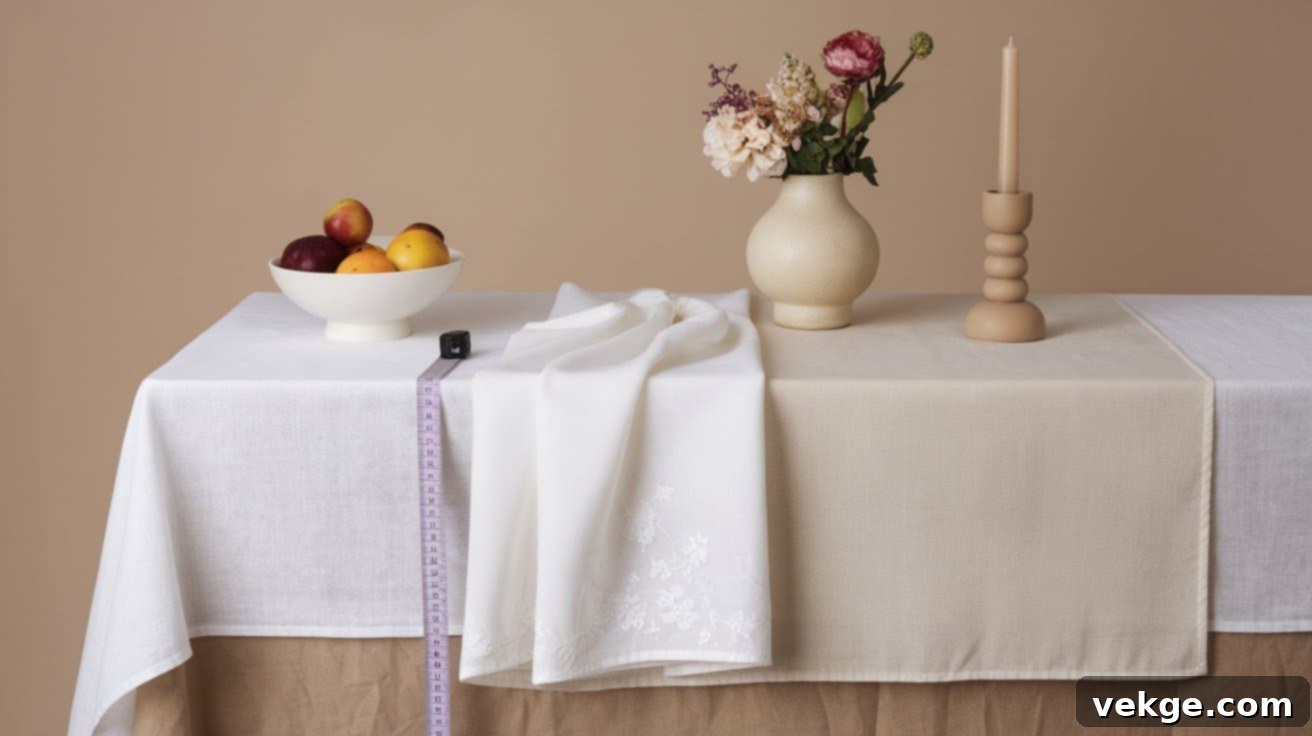Mastering Table Linens: Your Comprehensive Guide to Perfect Tablecloth and Runner Sizing
Have you ever found yourself in a dilemma, trying to choose the perfect tablecloth or table runner? It’s a common scenario. Perhaps you’ve dealt with a tablecloth that’s too short, leaving an awkward gap, or a table runner that drapes excessively, getting in the way of guests. Much like finding the ideal pair of jeans, achieving the right fit for your table linens is crucial for a polished, aesthetically pleasing look. A well-fitted tablecloth or runner can instantly elevate your dining experience, whether you’re hosting an elaborate dinner party or simply protecting your table during everyday family meals.
Fret not! This comprehensive guide is designed to empower you with all the knowledge needed to select the ideal fit for any table. We’ll meticulously walk you through the process of accurately measuring your table, understanding the nuances of different drop lengths, and choosing the perfect size tailored to various table shapes, from classic rectangular to elegant round designs. By the time you finish reading, you’ll be a true connoisseur, confidently selecting tablecloths and runners that fit impeccably, making every meal a stylish affair.
Determining the Right Sizes for Tablecloths and Runners
Achieving the perfect drape and coverage for your table linens hinges on understanding two primary elements: the overhang for tablecloths and the appropriate width and length for table runners. Let’s break down these crucial aspects to ensure your table settings are always on point.
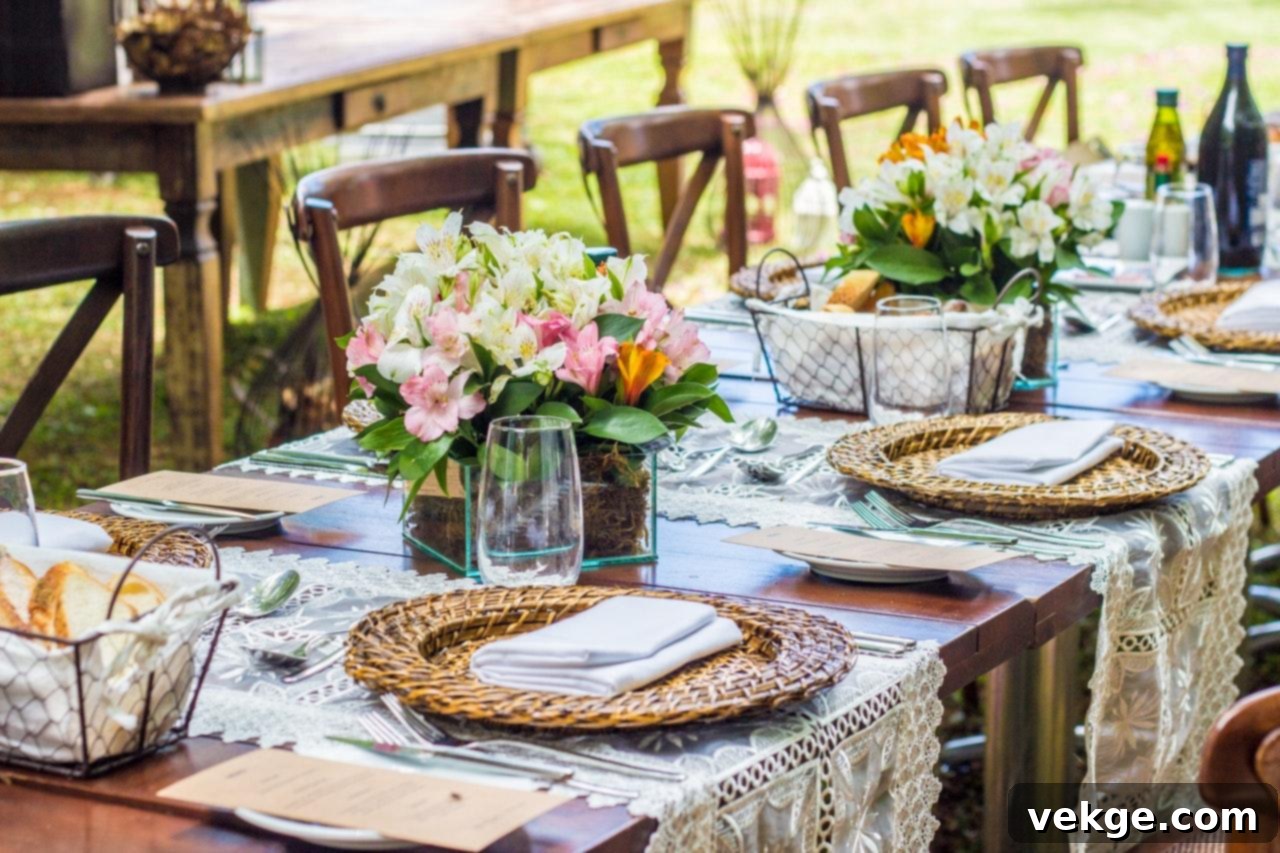
Tablecloth Overhang: The Key to Style and Formality
The “overhang” or “drop length” refers to how far the tablecloth hangs down from the edge of your table. This seemingly small detail significantly impacts the overall look and formality of your table setting.
- Casual & Everyday Look: For relaxed dining and daily use, an overhang of 6 to 12 inches on each side is generally ideal. This length provides good coverage without being overly formal or getting in the way of legs and chairs. It’s practical for family meals, breakfast nooks, or informal gatherings.
- Versatile & Semi-Formal: For a balanced look that works for most occasions, including holiday dinners, brunches, or slightly more elevated gatherings, aim for a drop length between 15 and 18 inches. This length offers an elegant drape that feels special but remains highly functional. It’s often considered the “sweet spot” for many households.
- Formal & Elegant Look: For grand dinner parties, weddings, or any occasion demanding maximum elegance, a 30-inch drop is typically desired. This length allows the tablecloth to gracefully reach the floor, creating a luxurious and sophisticated ambiance that conceals table legs and storage beneath.
Pro Tip: When considering your desired drop, always take into account the height of your table and the chairs. Ensure the tablecloth doesn’t hang so low that it interferes with seating comfort or gets easily snagged by guests’ feet.
Table Runner Dimensions: Adding Contrast and Definition
Table runners serve as a stylish accent, adding color, texture, and a touch of sophistication to your table. Their dimensions are just as important as a tablecloth’s to achieve the desired effect.
- Width: A good rule of thumb is for your table runner to be approximately one-third the width of your table. This proportion allows the runner to stand out without overwhelming the table or hiding too much of its surface. For example, on a 36-inch wide table, a 12-inch wide runner would be perfect.
- Length: The runner’s length should ideally extend 6 to 12 inches beyond the table’s edges on each end. This creates a pleasing visual drape without being so long that it becomes cumbersome or dips into guests’ laps.
- For a Bolder Statement: If you desire a more dramatic or modern look, consider a wider runner, up to half the table’s width. In such cases, a slightly shorter overhang (perhaps 4-6 inches) can create a contemporary feel, drawing attention to the runner’s design.
Tablecloth Sizing: Step-by-Step Measuring Instructions for Every Shape
Accurate measurements are the foundation of a perfectly fitted tablecloth. Let’s walk through the specific steps for the most common table shapes.
1. Rectangular Tables: The Classic Choice
Rectangular tables are ubiquitous in dining rooms, making their proper measurement essential.
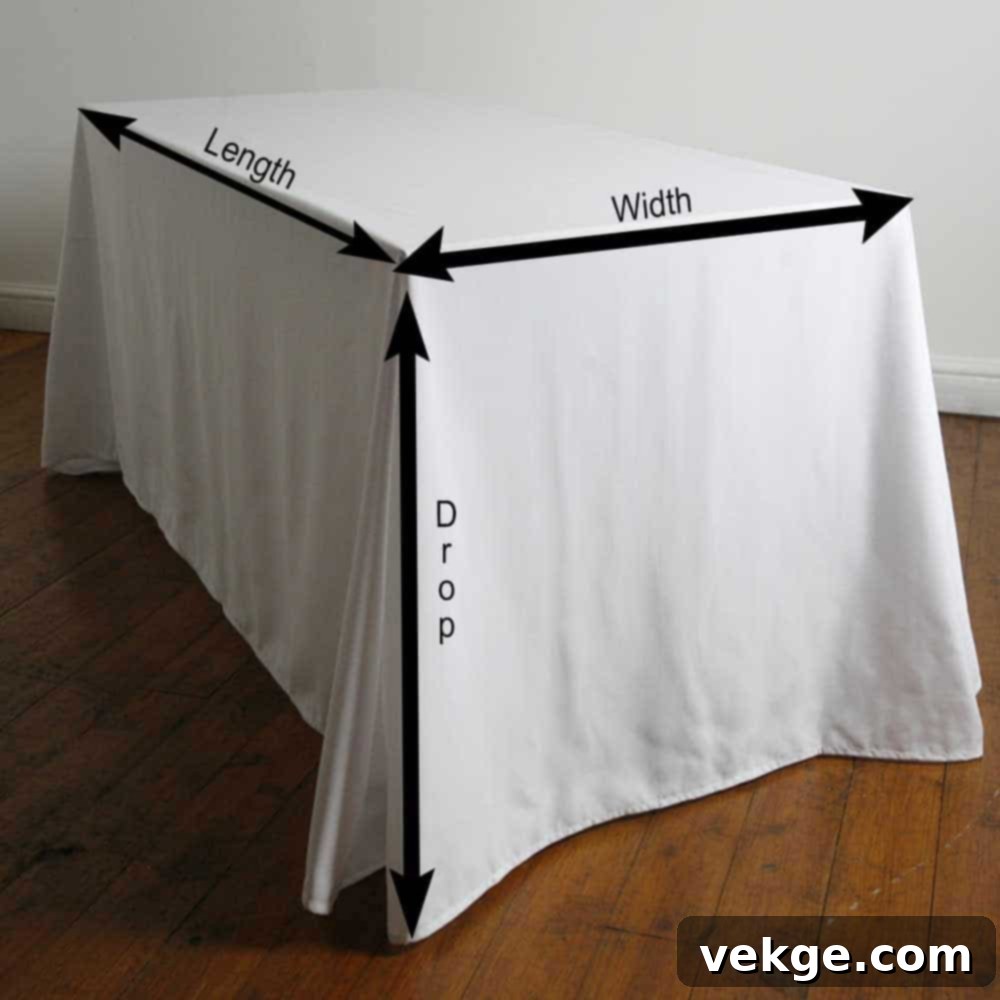
- Measure Length and Width: Begin by precisely measuring the entire length and width of your table surface. Use a flexible measuring tape for accuracy.
- Add Desired Overhang: For both the length and the width, you’ll need to add your desired drop length twice (once for each side).
- Calculation:
- Tablecloth Length = Table Length + (Desired Drop x 2)
- Tablecloth Width = Table Width + (Desired Drop x 2)
- Calculation:
- Example: For a 60-inch long and 36-inch wide table, if you want a 15-inch drop for a semi-formal look:
- Tablecloth Length = 60 inches + (15 inches x 2) = 60 + 30 = 90 inches
- Tablecloth Width = 36 inches + (15 inches x 2) = 36 + 30 = 66 inches
- You would need a 90 x 66 inch tablecloth.
2. Round Tables: Graceful and Inviting
Round tables often foster a sense of intimacy and conversation. Measuring for them requires a slightly different approach.
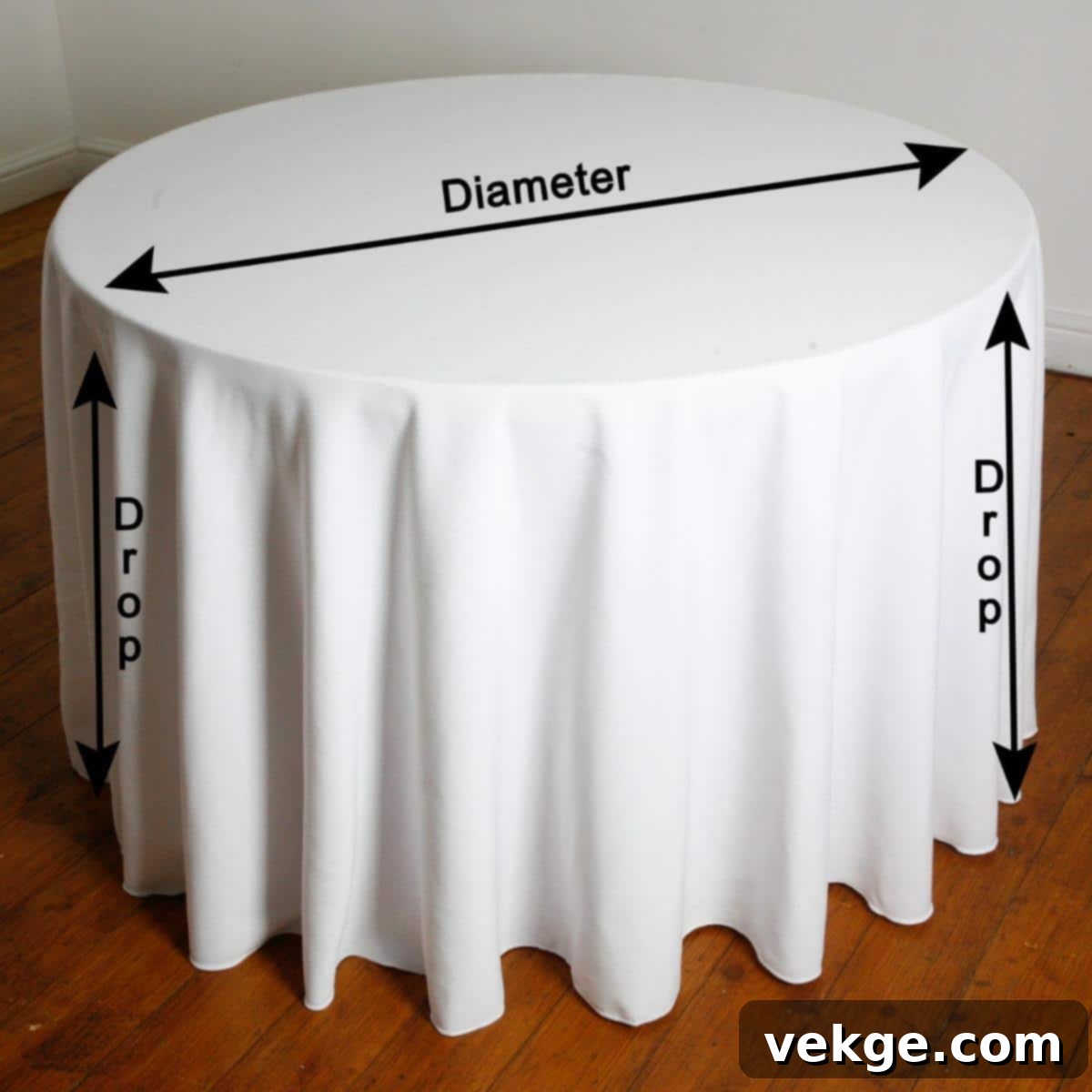
- Measure the Diameter: Use your measuring tape to find the widest point across the center of your round table. This is its diameter.
- Calculate Tablecloth Diameter: To determine the ideal tablecloth size, double your desired drop length and add it to the table’s diameter.
- Calculation: Tablecloth Diameter = Table Diameter + (Desired Drop x 2)
- For a casual look (12-inch drop): Tablecloth Diameter = Table Diameter + 24 inches
- For a formal, floor-length look (30-inch drop): Tablecloth Diameter = Table Diameter + 60 inches
- Sizing Round Table Runners: For a classic look, a runner should typically extend 6-12 inches beyond each edge. If you prefer a more contained, elegant look on a round table, a runner can be approximately 12 inches shorter than the table’s diameter. This allows it to lie centrally without overhanging too much, focusing attention on the table surface.
3. Square Tables: Modern and Chic
Square tables offer a contemporary aesthetic, and their tablecloths can be surprisingly versatile.
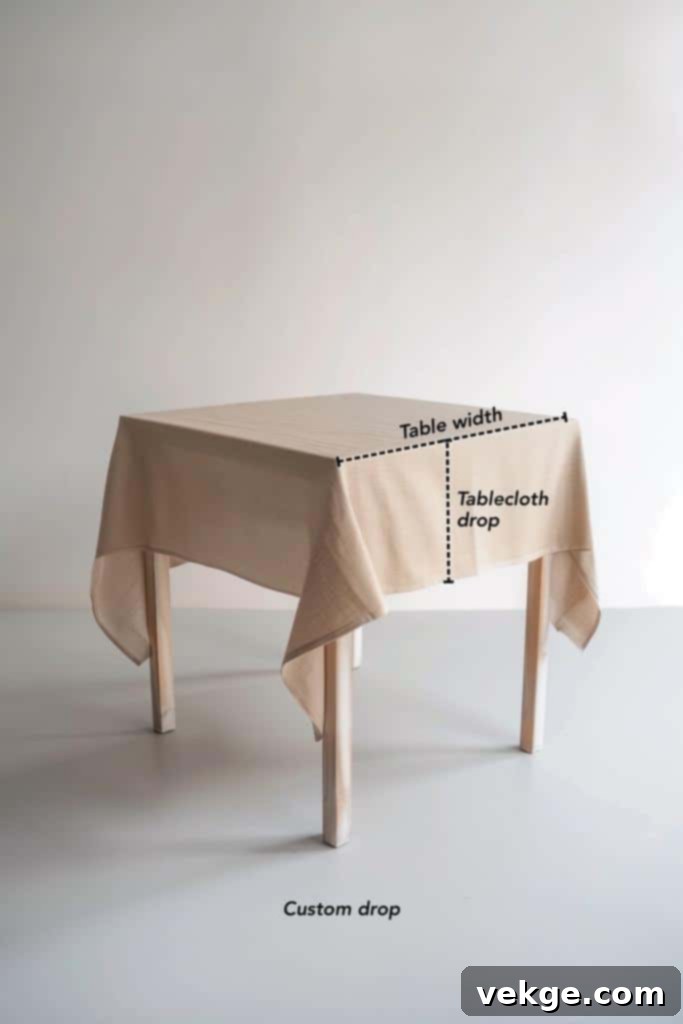
- Measure One Side: Since all sides are equal, simply measure the length of one side of your square table.
- Add Desired Overhang: Similar to rectangular tables, you’ll add your desired drop length twice to the side measurement.
- Calculation: Tablecloth Side Length = Table Side Length + (Desired Drop x 2)
- Creative Styling Tip: Consider using a round tablecloth on a square table for a unique and softer look. This creates elegant drapes at the corners. Just ensure the diameter of the round tablecloth is large enough to cover the corners adequately, often requiring a slightly larger diameter than a square tablecloth of the same drop would need.
Additional Considerations While Measuring Tablecloths
Beyond the basic measurements, several factors can influence your final choice and ensure your table linens serve their purpose beautifully and functionally.
- Account for Table Extensions: If your table has leaves or extensions, always measure it at its fullest, extended size. This guarantees proper coverage when you need it most, preventing the need for multiple tablecloths for different configurations.
- Formality of the Event: Reiterate that longer drops inherently create a more elegant, formal atmosphere, while shorter drops are practical and casual. Align your drop length with the tone of your event.
- Runner Styling: For square and round tables, runners can be arranged in various ways. A single center runner is classic. For a more dynamic presentation, especially for holidays or formal dinners, try an X-pattern with two runners. This not only adds visual interest but also provides a central point for decorations.
- Seating Comfort: Double-check that your chosen tablecloth length doesn’t hinder guests’ comfort. A cloth that hangs too low can get tangled around legs or be accidentally pulled, causing discomfort or spills. Ensure there’s ample legroom.
- Outdoor Use Considerations: For tables set outdoors, slightly shorter drops (around 6-8 inches) are often preferable. This minimises the risk of the wind catching the cloth and sending your beautifully set table into disarray. Consider using tablecloth clips or weighted tablecloths for extra security on breezy days.
By diligently following these comprehensive guidelines, you will confidently create perfectly dressed tables for any occasion. Remember, while these are expert recommendations, they serve as a foundation. Feel empowered to adjust based on your unique personal style, the specific dimensions of your space, and the mood you wish to create.
Practical Sizing Guidelines: Clever Tips for Diverse Table Types
Beyond the standard measurements, there are smart strategies for specific table types and scenarios that can enhance both functionality and aesthetics.
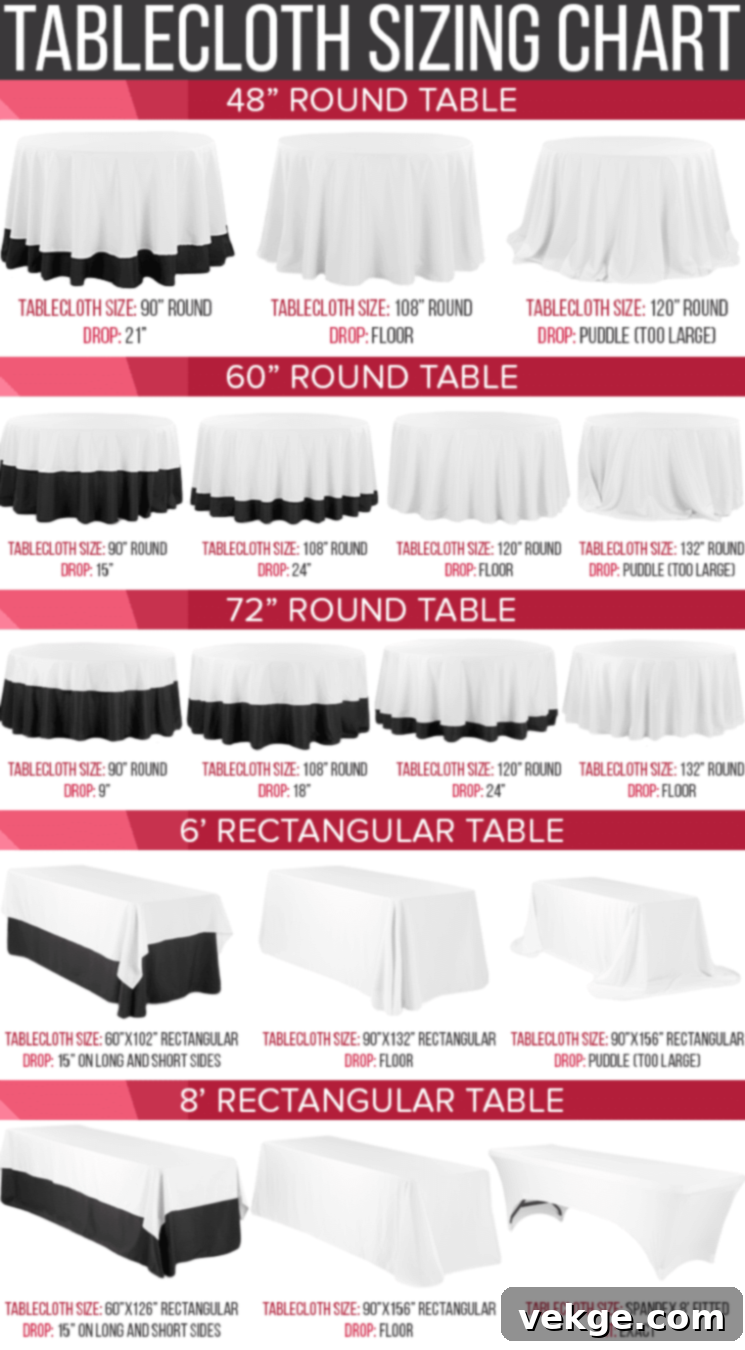
1. Buffet Tables: Functional Elegance
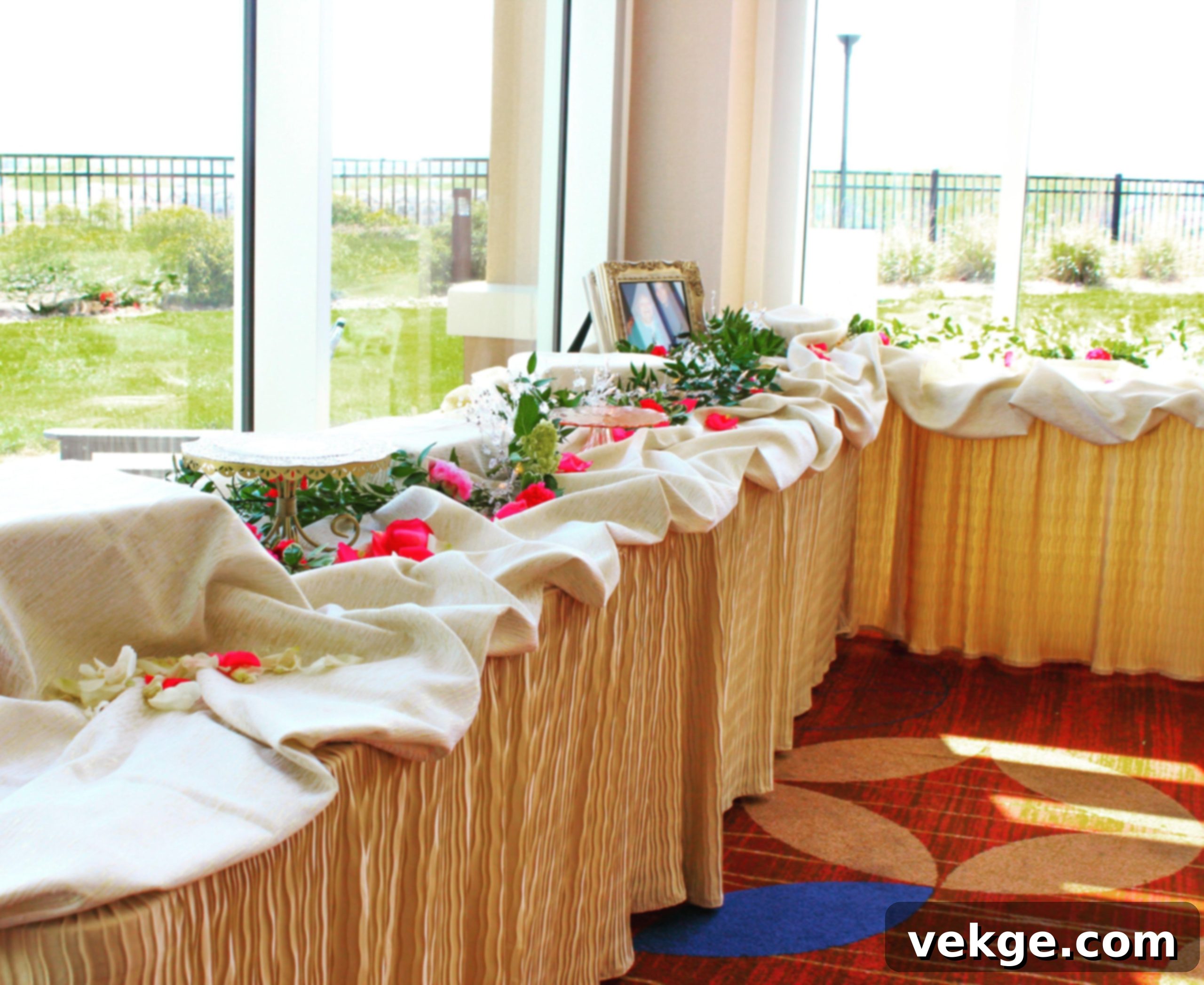
Buffet tables are designed for serving, not seating, allowing for more dramatic and functional drapes.
- Front and Sides: Opt for longer drops, ideally 15 inches or more, on the front and visible sides of the buffet table. This creates an elegant presentation and can discreetly hide serving essentials or storage beneath.
- Back Side: Keep the back side (facing a wall or where staff may need access) shorter, around 6-8 inches. This allows for easy access to items or power outlets without disturbing the drape of the tablecloth.
- Layering: Consider layering a smaller, decorative tablecloth or a series of runners over a plain, floor-length base cloth to add visual interest and define different serving stations.
2. Outdoor Tables: Durability Meets Style
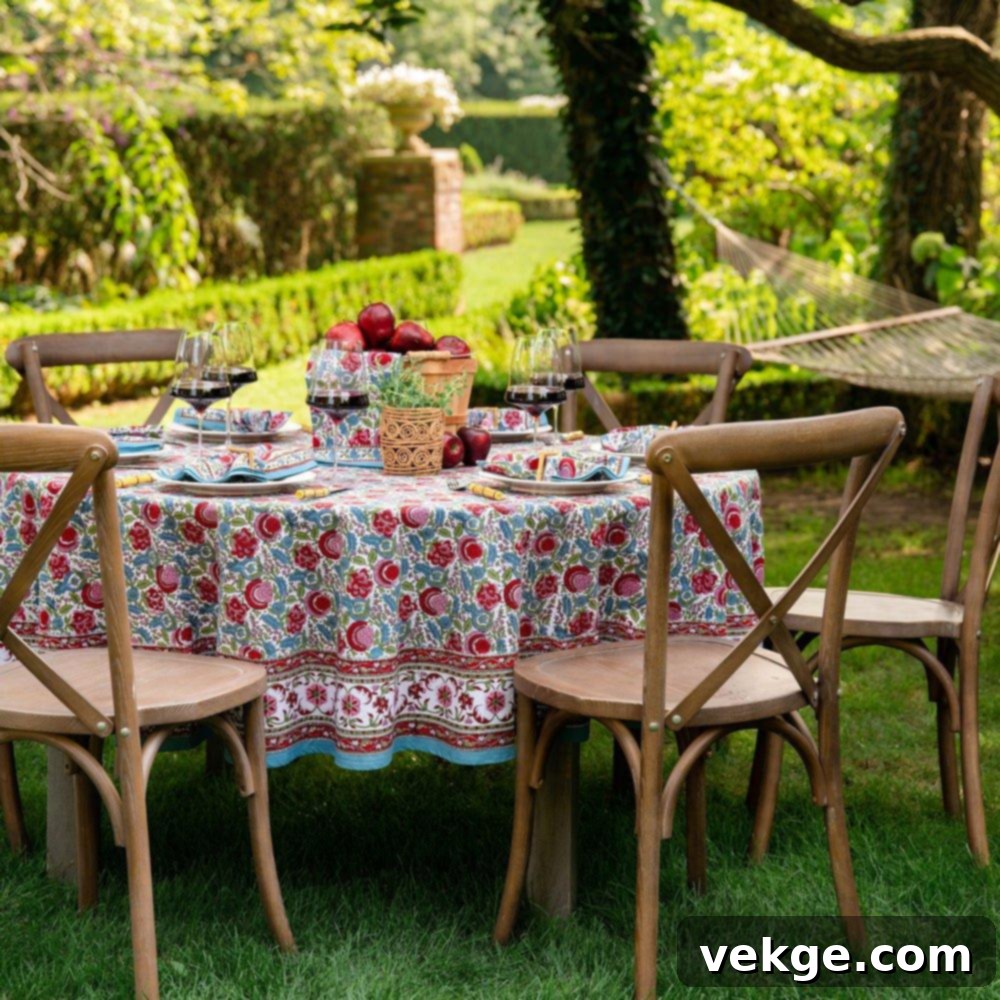
Outdoor dining presents unique challenges, primarily wind and uneven surfaces. Your sizing choices can mitigate these issues.
- Wind Resistance: As mentioned, slightly shorter drops (8-10 inches) are practical for outdoor tables to prevent the tablecloth from catching the wind.
- Security Solutions: Invest in weighted tablecloths or strong tablecloth clips, especially for windy days, to keep your linens securely in place.
- Creative Layering for Outdoors: To add visual flair without excessive fabric, layer a smaller square cloth diagonally over a larger round or rectangular one. This creates dynamic points without a heavy drape.
- Modern Asymmetry with Runners: For a contemporary outdoor setting, use multiple runners of varying lengths, perhaps in complementary colors, arranged in an asymmetrical pattern across the table.
Sizing for Special Occasions: Elevating Your Event Decor
Special events call for special attention to detail, and your table linens are a key component in setting the desired mood.
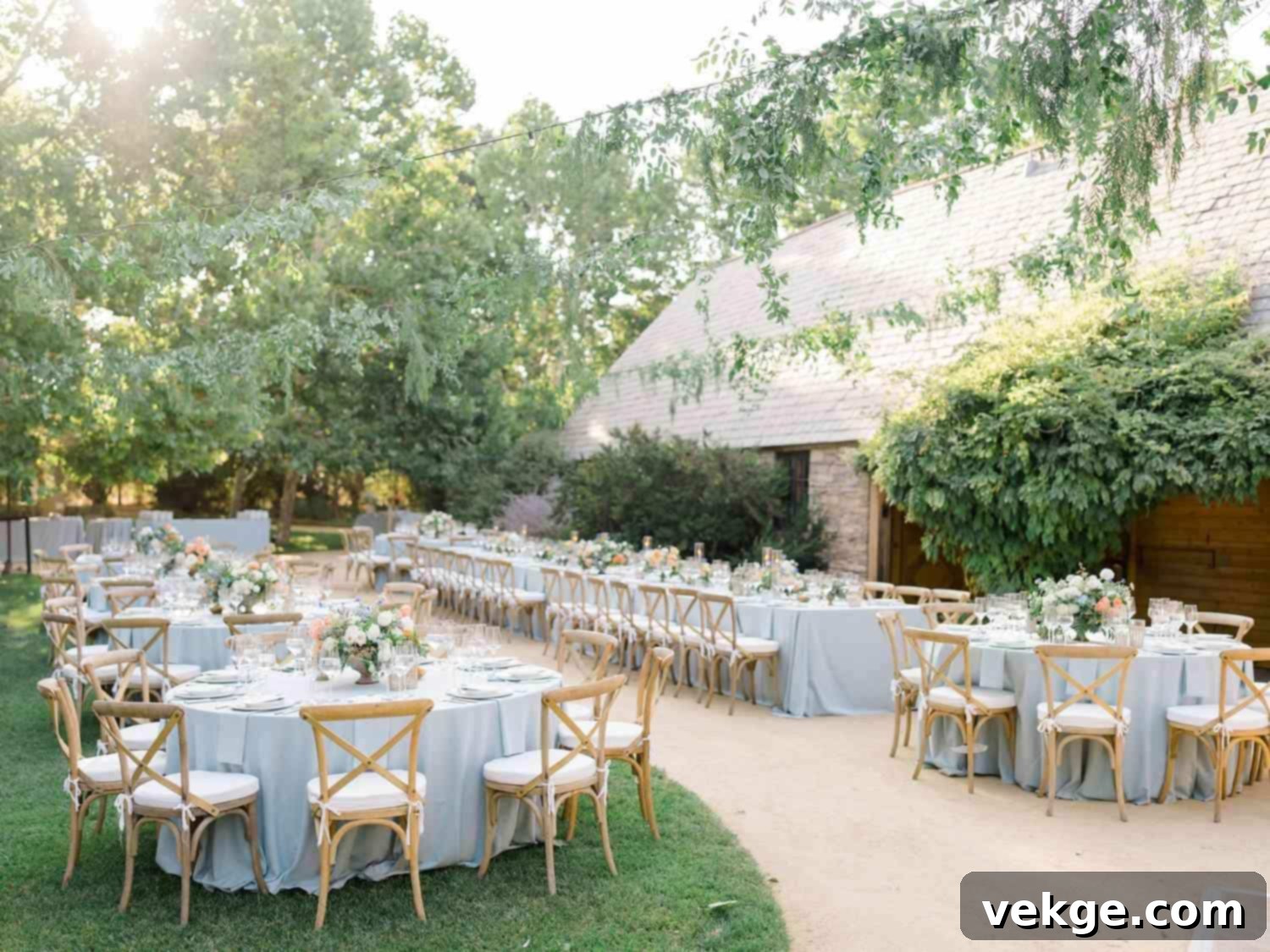
Wedding Tables: Grandeur and Detail
- Guest Book or Gift Tables: For these auxiliary tables, floor-length cloths (30-inch drop) are highly recommended. They create an extravagant, cohesive appearance, beautifully concealing any items stored underneath and contributing to the overall refined aesthetic of a wedding venue.
- Sweetheart Tables: For the bride and groom’s special table, consider extra-long runners that cascade dramatically off the front and sides. This creates a focal point and adds a touch of romantic opulence.
Adjusting for Seating Arrangements: Practicality Meets Elegance
- Banquet-Style Seating: When tables are arranged in long rows for banquet seating, ensure the tablecloth doesn’t hang so low that it obstructs guests from pushing their chairs in comfortably. A drop length of 15-18 inches is often perfect, allowing elegance without being cumbersome.
- Standing Cocktail Tables: These tables are typically higher and not meant for sitting. Therefore, use longer, floor-length cloths to completely hide the table legs, creating a clean and sophisticated presentation that also offers hidden storage.
Practical Tips for Tricky Situations: Problem Solved
- Uneven Surfaces: For tables with slight variations in height (common outdoors or with antique furniture), measure both the shortest and longest sides/points. Then, choose a tablecloth size with a drop length that offers acceptable coverage for both, often a middle-ground measurement.
- Tables with Central Poles: Patio tables with umbrella holes or other central obstructions require specific solutions. Look for tablecloths specifically designed with umbrella holes, or use multiple smaller cloths artfully layered around the pole for a customised fit.
By considering these diverse and practical scenarios, you can confidently select tablecloth and runner sizes that not only fit flawlessly but also enhance the specific setting and occasion, leaving a lasting impression on your guests.
Advanced Tips and Additional Considerations for Table Linen Perfection
Ready to move beyond the basics? Let’s delve into expert-level advice for handling unique table situations, ensuring your linens are always impeccable, and truly mastering the art of table dressing.

Handling Irregular Table Shapes: Custom Fit Solutions
Not all tables are perfectly rectangular or round. For those uniquely shaped pieces, a custom approach is often best.
- Oval Tables: Measure the longest point (length) and the widest point (width) of the table. Then, apply the same “Table Length + (Desired Drop x 2)” and “Table Width + (Desired Drop x 2)” formulas as for rectangular tables. While a rectangular tablecloth can work, an oval tablecloth specifically cut to size will provide a more elegant and symmetrical drape.
- Hexagonal or Asymmetrical Tables: For tables with more than four sides or irregular shapes, it’s crucial to measure each individual side and the longest diagonal across the table. Often, custom-made tablecloths are the best solution here to ensure an even overhang and a truly tailored fit. Alternatively, consider using multiple smaller, coordinating runners or placemats to define place settings without requiring a single, complexly shaped cloth.
Layering Techniques for Tablecloths and Runners: Adding Depth and Style
Layering is a powerful tool to add visual interest, texture, and sophistication to your table setting.
- Formal Overlay: For a truly opulent effect at formal events, start with a floor-length base tablecloth in a neutral or complementary color. Then, add a shorter overlay cloth (e.g., a square cloth rotated to create diamond points) in a contrasting color or luxurious fabric (like lace or silk) on top. The top layer should typically be 6-8 inches smaller in diameter or length/width than the base layer for a distinct, polished edge.
- Runner Pairings: Experiment with contrasting colors or textures for your runners. For example, place a solid-colored runner directly on the table, then layer a narrower, patterned runner on top of it. This adds dimension without the bulk of multiple full tablecloths.
- Seasonal Layering: Use layering to adapt your table for different seasons or holidays. A simple base cloth can be transformed with a festive overlay or themed runners.
Special Considerations for Different Events and Settings
1. Outdoor vs. Indoor Use: Adapting to Environments
Reiterating and expanding on environmental factors:
- Outdoor Dynamics: As previously mentioned, wind is a major factor. Shorter drops (about 6-8 inches) are ideal. Also, consider the material: durable, easy-to-clean fabrics like polyester are excellent choices for outdoor settings.
- Uneven Surfaces Outdoors: Outdoor tables, especially picnic tables or those on patios, can have slightly uneven surfaces or built-in benches. When measuring, account for these variations. For built-in benches, ensure your tablecloth doesn’t impede seating or cause an awkward bunching. Sometimes, two smaller, perfectly sized cloths can work better than one large one.
- Indoor Stability: Indoors, you have more freedom with longer drops. The primary concern becomes aesthetics and ease of movement around the table.
2. Choosing the Right Drop Length: A Visual Guide
To help solidify your understanding of drop lengths, here’s a quick visual guide to consider when styling your table:
- Casual Dining (6-8 inch drop): Practical, modern, and excellent for showcasing unique table legs or for active, everyday use where minimal overhang is desired.
- Semi-Formal (15-18 inch drop): The versatile “sweet spot.” This length provides an elegant drape suitable for most dinner parties, holidays, and special family gatherings, balancing sophistication with usability.
- Formal Events (30-inch drop / Floor-Length): The ultimate in elegance and luxury. This full drape conceals table legs and creates a seamless, opulent look, perfect for weddings, banquets, and high-end events.
Remember, these are established guidelines. Your personal preference, the height of your specific table, and the overall aesthetic you’re aiming for should always guide your final decision.
3. Dealing with Table Extensions and Leaves: Flexible Solutions
Expandable tables offer great flexibility, but they can be a challenge for tablecloths. Here are some smart solutions:
- Multiple Tablecloths: The most straightforward approach is to own two tablecloths – a smaller one for your table’s everyday, unextended size, and a larger one for when the leaves are added.
- Strategic Table Runners: Table runners can be incredibly useful when your table is extended. Position them strategically to bridge the gap where the leaf meets the main table, effectively camouflaging the seam and creating a continuous decorative element. You can even use multiple runners laid perpendicular to each other for an interesting grid pattern.
- Custom-Made Options: If you frequently use your table at its extended length, investing in a custom-made tablecloth that perfectly fits the extended dimensions can be a worthwhile investment.
4. Specialty Fabrics and Their Impact on Sizing: Understanding Material Properties
The type of fabric significantly influences how a tablecloth hangs and behaves over time, impacting your sizing choice.
- Natural Fibers (Linen, Cotton): These fabrics are prone to shrinking after washing, especially if dried on high heat. When purchasing tablecloths made from natural fibers, it’s wise to consider sizing up by 2-3 inches in both length and width to accommodate for this potential shrinkage, ensuring it maintains the desired drop after laundering.
- Synthetic Blends (Polyester, Spandex): Polyester is generally very stable and resistant to shrinking or stretching. Spandex blends, on the other hand, offer significant stretch. For stretchy fabrics, you can often stick to the exact measured dimensions, or even slightly size down, as the fabric will conform to the table. They are excellent for fitted table covers.
- Delicate Fabrics (Silk, Lace): These often require dry cleaning or very gentle care, so shrinkage is less of a concern. Focus on the initial drape and aesthetic.
Understanding these fabric properties will help you make an informed decision and ensure your chosen tablecloth remains the perfect fit for many years to come.
Final Thoughts: Your Journey to Table Linen Mastery
Congratulations! You are now equipped with an extensive understanding of how to select the ideal size for your table coverings. With our comprehensive guidance, you possess the expertise to adorn your table like a seasoned decorator for any event or occasion.
The essence of perfecting your table setting lies in a few key principles: performing accurate measurements, thoughtfully considering the formality and type of event, and confidently adding your unique flair through creative choices. Whether you’re orchestrating a relaxed family brunch or a sophisticated formal dinner, you now have the tools to achieve an impeccable fit and a captivating presentation.
Remember to feel empowered to explore beyond the traditional: experiment with creative layering techniques, consider custom sizes for those wonderfully unusual table shapes, or even blend different textures and patterns. The world of table decor is vast and inviting!
Why not put your newfound knowledge into practice right away? Begin by meticulously measuring your primary dining table and envisioning your next exquisite table arrangement. If you ever feel uncertain, don’t hesitate to try different combinations – sometimes, the most unexpected pairings lead to the most memorable and admired dining settings.
We are genuinely curious about your upcoming table decorating plans! Share your inspired ideas and newfound styling successes in the comments below. Let your creativity shine and transform every meal into a beautifully presented experience!
